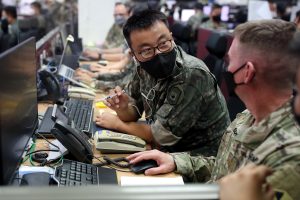After four years of scaled back military exercises designed to encourage negotiations with North Korea, the United States and South Korea have resumed large-scale military drills with Ulchi Freedom Shield. The resumption of large-scale military exercises should improve military readiness, but it will likely remain a point of contention in regards to North Korea’s nuclear program.
North Korea has long opposed joint South Korea-U.S. military exercises, which Pyongyang views as part the United States’ “hostile policy” and practice for an invasion. Prior to the beginning of Ulchi Freedom Shield, Kim Jong Un even accused the United States and South Korea of bringing the Korean Peninsula to the “brink of war.”
The United States and South Korea had scaled back military exercises during efforts at negotiations with North Korea under the Trump and Moon administrations. They initially began scaling back military exercises in early 2018 with the annual Foal Eagle/Key Resolve joint military drills. Those drills were delayed to avoid taking place during the PyeongChang Winter Olympics and ultimately shortened. They were also scaled back to avoid using strategic assets such as nuclear submarines and aircraft carriers to improve the environment ahead of the anticipated first summit between Donald Trump and Kim Jong Un later that year.
Those were not the only changes to the drills in recent years. After the first North Korea-U.S. summit in Singapore, then-President Donald Trump announced that the U.S. and South Korea would halt large-scale joint military exercises. This, however, was a decision taken without consulting South Korea, some U.S. officials, or Kim Jong Un. Instead, Trump said he had decided to cancel the exercises to reduce costs.
The U.S. and South Korean militaries adjusted to the decision to end large-scale military drills by turning to computer simulations and small unit level exercises.
The pandemic was also a factor in the decision to scale down exercises in previous years. Early in the pandemic some exercises were ultimately canceled due to outbreaks of COVID-19 among troops, while last year’s exercises were limited to computer simulations.
However, with North Korea resuming ballistic missile tests and showing no interest in returning to talks, there is little reason for the United States and South Korea to refrain from resuming large-scale military exercises in 2022.
While Ulchi Freedom Shield is expected to include traditional exercises such as joint frontline training, simulations removing weapons of mass destruction, joint aircraft carrier strike drills, and amphibious landing training, the exercises have also been updated to reflect some of the new tactics seen in Russia’s invasion of Ukraine. They will include training for joint military-civilian responses to attacks on key civilian infrastructure facilities.
Ulchi Freedom Shield will also be the first joint exercise with the deputy commander of Combined Forces Command, General Ahn Byung-Seok, leading the exercise. The change is designed to prepare for the eventual transfer of wartime operational control to South Korea.
After four years of small-scale exercises and computer simulations, the return to large-scale exercises should help to improve military preparedness. Given the limitations on exercises in recent years, few troops have taken part in prior large-scale combat exercises since most South Korean troops serve 18-month conscriptions and U.S. tours range between two to three years.
The joint exercises, however, are likely to remain a point of contention in efforts to denuclearize North Korea.
As part of a reform to the veto process at the United Nations Security Council, permanent members are now required to explain their vetoes. The first use of this reform came in response to a resolution focused on North Korea’s ballistic missile tests earlier this year. In explaining China’s veto, Ambassador Zhang Jun stated the “United States [had] returned to the old path of ‘strategic patience and maximum pressure,’ increasing sanctions against the Democratic People’s Republic of Korea, which intensified that country’s distrust of the United States, bringing talks to a complete deadlock.” To resolve this issue, he suggested that the United States could ease sanctions and end joint military exercises with South Korea.
Zhang’s comments, of course, ignore that North Korea walked away from talks after the 2019 working-level meeting in Stockholm, which sought to revive talks after their breakdown in Hanoi.
While the military exercises are likely to remain a flash point for North Korea, they are a necessary step for improving readiness in a changing strategic environment. They are also essential for the United States and South Korea to move forward with plans to return wartime operational control to South Korea. Should North Korea return to talks there may be a logic to again scaling back the exercises, but that should be driven by the strategic interests of the South Korea-U.S. alliance rather than North Korean rhetoric about U.S. hostile policy.

































